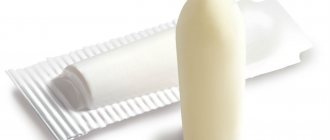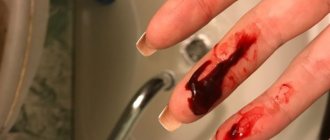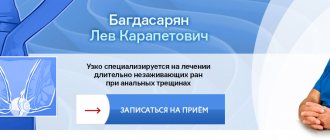Home » Hemorrhoids » Chronic hemorrhoids
Sign up for a consultation with a proctologist for the treatment of hemorrhoids for 3,500 rubles and receive a treatment prescription within 30 minutes for 1 appointment
Find out what day you need to make an appointment to get a consultation without a queue.
Experience 44 years 73 operations per month 876 operations per year 171 reviews Author of 73 scientific papers Has 9 patents 6,818 requests per month
Call
Chronic hemorrhoids are an expansion of the venous plexus that occurs over a long period of time. Initially, the patient is diagnosed with an acute form of pathology, which, if left untreated, develops into chronic hemorrhoids. Venous plexuses are located in the submucosal layer of the lower rectum and in the subcutaneous area near the exit from the anus.
Proctological disease is accompanied by anal bleeding and an increase in the size of hemorrhoidal cones. The tumors bleed, become inflamed and fall out of the anus, which brings discomfort to the patient. Itching and burning in the anus, pain syndrome appears.
Chronic hemorrhoids of any degree are diagnosed after obtaining anamnesis and information about symptoms.
Medical statistics
Chronic hemorrhoids are considered a chronic pathological phenomenon, which is accompanied by an increase in the arteriovenous cavernous plexuses in the anus. Accompanied by anal bleeding, thrombosis and anemia as a result. Hemorrhoids fall out and become pinched. Hemorrhoids are the most common disease in the field of proctology. Pathology is diagnosed in 14.5% of the population of the Russian Federation. Men who work physically are at risk.
According to medical statistics, 80% of patients seek help when the situation worsens. In the early stages, the disease does not manifest itself in any way, so it is almost impossible to identify it without diagnostic tests. Hemorrhoids are usually detected during a routine medical examination.
Operation
If conservative methods do not help, surgical intervention is resorted to.
- Ligation with latex rings is used in the second (third) stage of internal hemorrhoids. The procedure is performed on an outpatient basis using an anoscope. The bottom line is that hemorrhoidal nodes are compressed with special latex rings, as a result the problem solves itself - the blood supply to the nodules is disrupted, and they simply die. The procedure is effective and inexpensive, but quite painful and long - only one node can be treated in one session.
- Infrared photocoagulation is performed under local anesthesia and does not require hospitalization of the patient. With this method, the affected area is treated with light waves of the infrared spectrum, which leads to the cessation of blood supply and drying of the node. The disadvantage of this method is the risk of blood clot formation at the cauterization site.
According to indications, sclerotherapy, laser coagulation, and cryotherapy can be used. However, the most effective and drastic way to solve the problem is considered to be hemorrhoidectomy - removal of hemorrhoids using the usual surgical method.
Causes
Proctologists identify a number of reasons that provoke the development of hemorrhoids. These include genetic predisposition. In this group of the population, increased intra-abdominal pressure and impaired functioning of the esophagus are observed in utero. Experts call a sedentary lifestyle one of the main reasons. An unbalanced diet, disrupted daily routine and lack of normal sleep lead to a deterioration in metabolism, which provokes an increase in hemorrhoidal cones. Heavy physical activity and gastrointestinal disorders are among the factors that influence the appearance of chronic hemorrhoids.
More often, the disease is diagnosed in people who often strain during bowel movements, and in those who suffer from multiple bowel movements. Feces come out of the rectum several times at intervals of several minutes. Accelerating bowel movements by pushing leads to the formation of anal fissures and scars. In women, hemorrhoids develop during pregnancy, as the uterus puts pressure on the internal organs. The abdominal organs are especially affected by intra-abdominal pressure.
Diet food
The main focus of the diet is to eat foods that do not cause constipation and intestinal problems. The daily diet should include foods filled with fiber, so you need to eat a lot of vegetables, fruits and all kinds of cereals. It is important to consume dairy products and lean meats. Food should be boiled or steamed.
You should not use:
- pickles;
- canned food;
- fatty and fried foods;
- spicy dishes;
- smoked meats;
- alcohol;
- coffee.
It is important to ensure that the body receives a sufficient amount of fluid; to do this, you should drink at least 2 liters of water per day.
Pathogenesis
Proctological disease develops when the arteriovenous cavernous plexuses increase and form during intrauterine development. Outwardly they resemble the corpora cavernosa of the genital organs. The plexuses are located above the dentate line or on the mucous membrane in the lower rectum. They are also localized under the dentate line, in the subcutaneous tissue in the anal canal. The plexuses are connected to each other using anastomosis.
The corpora cavernosa in the anus fill with blood and are responsible for sealing the closed sphincter. Previously, proctologists believed that chronic hemorrhoids develop due to varicose veins in the affected area. Today, there are a number of factors that influence the impaired functioning of internal organs. These include an increased amount of blood in the corpora cavernosa, as arterial inflow accelerates. Venous outflow slows down. Thrombosis forms, which leads to anemia, and the vascular wall of the anus becomes inflamed.
The superior rectal artery becomes wider than in healthy people. The number and density of blood vessels in the anal area increases. Muscles and veins weaken, become thinner, and worn out. Hemorrhoids enlarge and prolapse from the rectum. When defecating, the patient strains, thereby putting pressure on the exit of feces. Nodes move in the wrong direction.
Complications
Complications of internal hemorrhoids include:
- vein thrombosis;
- strangulation of hemorrhoids;
- loss of varicose formations;
- rectal bleeding;
- insufficiency of the anal sphincter.
Hemorrhoids lead to stagnation of blood in the veins, and this causes thrombosis. Symptoms of this complication are an enlargement of the nodes, their acquisition of a bluish-purple hue and sharp pain in the perianal area, which increases during palpation.
A frequent complication of stages III-IV is constant bleeding from the cavernous bodies. With it, the patient complains of general weakness (which is due to increasing anemia). Tests show a drop in blood hemoglobin to 40-50 g/l.
In elderly patients, frequent prolapse of nodes against the background of progressive hemorrhoids in some cases leads to weakness of the anal sphincter. This complication is manifested by incontinence of gases and even the contents of the rectum (liquid fecal matter).
Stages of hemorrhoids
Depending on the course of the disease, the following stages are distinguished:
- hemorrhoids of the 1st degree - drip bleeding from the anus opens. Pain syndrome appears in the anal area. Hemorrhoids are small, so they do not fall out of the rectum. The vascular pattern of the mucous membrane is enhanced. Pathological changes in the muscular-ligamentous framework develop;
- hemorrhoids of the 2nd degree - heavy bleeding opens, itching and burning appears in the anus. Mucus is released, the size of hemorrhoids is rapidly growing. The tumors fall out, but the patient can set them back without the help of a medical specialist. Dystrophic changes in muscles are observed;
- Hemorrhoids 3rd degree - hemorrhoids fall out after each bowel movement. The patient tries to move them inside on his own. Muscles become less elastic, ligament and muscle degeneration progresses. Pain increases even in a sitting position;
- hemorrhoids of the 4th degree - the pain intensifies, discomfort is present even in a sitting position. Fecal incontinence begins. Hemorrhoidal cones fall out when walking, coughing and sneezing. Severe muscle dystrophy is diagnosed.
You should contact a proctologist as early as possible in order to begin treatment at the initial stage of hemorrhoids and avoid complications.
How to prevent hemorrhoids?
Effective treatment of this disease is impossible without preventive measures. Every patient must know not only how to treat hemorrhoids, but also how to avoid their occurrence.
- Eliminate constipation. A special diet, as well as laxatives, will help with this.
- Avoid strenuous physical activity and lift weights correctly.
- Lead an active lifestyle: walks, gymnastics, physical education.
- During pregnancy, use the knee-elbow position for prevention several times a day.
- Prevent the development of obesity.
If you follow these recommendations, the appearance of internal hemorrhoids can be avoided.
Chronic hemorrhoids, symptoms
Initially, the patient is diagnosed with an acute form of hemorrhoids, which soon becomes chronic. The patient feels discomfort when defecating, pain appears in the anus. Every day the pain intensifies. Profuse bleeding with impurities of pus and mucus appears. Hemorrhoids are damaged by feces during bowel movements, resulting in bloody discharge and clots from the anus. The color of blood is bright scarlet. Discharges flow from the arteries that supply blood to the arterial and venous cavernous plexuses.
If blood remains in the rectum, it comes out after bowel movements in the form of dark clots and mucus.
Symptoms of hemorrhoids differ depending on the stage and course:
| Initial stages | Late stages |
| Bleeding is not profuse. Occurs with an unbalanced diet and constipation. The symptom disappears on its own without the help of a medical specialist. The patient notices discharge on underwear, on the bed, on toilet paper. Appear by drip or small stream. | Bleeding is considered profuse. Appears after each act of defecation and even when walking and during physical activity. Pus and mucous discharge are released. The patient seeks help from a proctologist, as the profuseness intensifies. Bleeding leads to iron deficiency anemia or anemia. Heavy discharge is observed more often in the male half of the population. |
| The size of hemorrhoids is small, however, they can be felt by palpation. They are elastic and do not fall out of the anus. The size of the neoplasms is 2 centimeters. Palpation does not cause discomfort and is considered painless. | In advanced stages, the size of hemorrhoids increases, and prolapse from the rectum is observed. Palpation becomes painful and uncomfortable. |
| The pain syndrome is present only during bowel movements and does not bring severe discomfort to the patient. There is a burning and itching sensation in the anus. | The intensity of the pain increases, the itching does not go away even in a sitting position. The patient notices a pulsating sensation that intensifies with movement and coughing. Sleep is disturbed. |
A large amount of mucus is released from the anal area. Itching appears due to dermatitis, which develops as a result of taking medications. Soft tissues become dense, inflamed and swollen.
In some cases, an increase in temperature and blood pressure is observed. Appetite disappears, the patient feels tired.
A frank conversation with a proctologist: there is nothing terrible about hemorrhoids!
Hemorrhoids in a certain sense can be called a unique disease. Due to its location in the anal area, discussing this disease with other people, even with a doctor, is not easy for most people. As a result, there are a huge number of rumors about hemorrhoids that have nothing to do with reality.
We asked an oncologist, proctologist and surgeon, a member of the board of the Russian Society of Endoscopic Surgeons, a member of the international committee of the American Society of Colorectal Surgeons, a member of the Society of American gastrointestinal and endoscopic surgeons, head of the International School of Practical Surgery, head of the GMS Clinic surgery center, advisor to the head of the Republic of Kalmykia on healthcare Badmu Nikolaevich Bashankaev.
— Today we would like to discuss with you such a problem as hemorrhoids. There is evidence that 70–80% of people develop hemorrhoids during their lifetime, although no more than 10–15% seek medical help. How accurate are these numbers? What are the causes of hemorrhoids?
— In the United States, it is believed that about 4–10% of the population suffers from some form of hemorrhoids. In Russia, data sometimes appears that 80% of our people suffer from hemorrhoids. Hearing such numbers, I keep repeating the standard joke: maybe this is “mental hemorrhoids”, “hemorrhoids of thoughtfulness and reflection”? It happens like this: a person comes in, and it’s clear that he has “hemorrhoids” throughout his life, and he doesn’t have physical hemorrhoids, but he does have mental ones. So the data that 80% of the population suffers from hemorrhoids does not correspond to the true incidence. Although, of course, if we are talking about people over 50 years old, then among them the number of people suffering from hemorrhoids is really high. By this age, approximately 30–40% of mature people in Europe have hemorrhoidal complaints such as blood from the anus, itching near the anus, discomfort, prolapse of nodes.
Let me remind you that in the distal part of the rectum (the upper part of the surgical anal canal), covered with the rectal mucosa and without pain sensitivity, there are internal hemorrhoidal plexuses - internal hemorrhoids, and in its lower part, covered with skin richly innervated by pain receptors, there are external hemorrhoidal plexus - external hemorrhoids. External and internal nodes are separated by a “jagged” line. This is the confluence of the mucosa and the anoderm. The height of the entire anal canal in women is about 2-3 cm, in men - up to 5 cm, therefore, with significant swelling, thrombosis or a long history of the disease, the external and internal merge (combined form), even for surgeons it is difficult to differentiate groups of nodes. In this regard, there are features of the manifestation of hemorrhoidal disease: external hemorrhoids almost always only hurt while they swell or thrombose, and the internal hemorrhoids fall out of the anus and bleed, causing itching and discomfort.
The causes of hemorrhoids are not fully known. There are several theories (at least three). One of them, which I like, explains that the basic, fundamental feature of the formation of hemorrhoids is our upright posture, and only then all other factors. The fact is that animals do not have hemorrhoids, because they walk on four legs and their blood does not rush there, there is no combination of straining and hydrostatic pressure. And we humans began to walk, and we developed diseases of the spine, veins of the lower extremities and hemorrhoids caused by upright walking. For example, the structure of the anal canal is two muscles (internal and external sphincters) that wrap around each other in order to prevent an accidental fart or how. However, they still did it somewhat loosely. Therefore, hemorrhoids are probably a sealing membrane, like the petals that cover the diaphragm in a camera. When straining, they slip into the anal canal. Accordingly, it is most often believed that a person develops hemorrhoids as a result of a combination, in addition to upright walking, of various predisposing factors, such as heredity, a sedentary lifestyle, pregnancy, chronic constipation, straining, heavy lifting, and obesity. However, we do not know 100% what causes hemorrhoids. And if you don’t know the cause of the disease, then you cannot prevent it 100%.
— How serious a problem is hemorrhoids? What are its symptoms and what tests are needed to confirm the diagnosis? What complications can develop with hemorrhoids?
— In most cases, this is simply a decrease in the quality of life: itching, loss of nodes and bleeding bring some inconvenience.
A lot depends on the stage of hemorrhoids. We usually use the English classification for internal hemorrhoids. For the outdoors there are degrees.
So, the first stage of internal hemorrhoids is characterized by bulging nodes and periodic bleeding. At the second stage, the nodes increase in size and prolapses are added (but the nodes are corrected on their own). The third stage manifests itself in the same way as the initial ones, however, when the nodes fall out, they no longer correct themselves and you need to help with your hand or finger. At the fourth stage, there is a constant loss of bleeding nodes, which can no longer be reduced into the anus.
The first and second stages are most common, so usually hemorrhoids are simply periodic bleeding, prolapse of nodes, discomfort, and itching. Sometimes in severe cases, when a person does not go to see a doctor for a long time, anemia may develop.
At the same time, I want to say that even in the absence of complaints, people should have a culture of visiting a proctologist, because even if a person is completely healthy and has no relatives with colon diseases. anus, then at the age of 45 you still need to come to the proctologist for an appointment, discuss with the doctor the need for a colonoscopy and have it done. And if you have hemorrhoidal complaints, a trip to a proctologist is inevitable, since the main diagnostic method for hemorrhoids is examination and anoscopy: we insert a short plastic or iron tube into the anus and see how the nodes fall out. It is not difficult.
— What do you think about the statement that hemorrhoids lead to cancer and are one of the leading causes of death?
— Hemorrhoids reduce the quality of life, but they never develop into cancer. A true hemorrhoid itself cannot transform into cancer. A polyp can grow on it, but cancer never occurs in the arteriovenous hemorrhoid itself.
In fact, hemorrhoids are a social disease that primarily changes a person’s mood. It is clear that when a person constantly sees blood in the toilet or on toilet paper, he begins to worry to the point that panicky thoughts about death appear. But hemorrhoids cannot be the leading cause of death, if only mentally, in the form of depression. And so, there is nothing terrible about hemorrhoids.
But sometimes hemorrhoids can mask cancer. And even a proctologist can make a mistake and start treating hemorrhoids. But 4 weeks, 8 weeks pass, and the bleeding continues. Thus, you can never relax. It is necessary to do a colonoscopy to be sure not 99%, but 100% that it is hemorrhoids and not cancer. You must always remember that rectal and colon cancer is the most common type of cancer and always remain vigilant about this disease.
— How to treat hemorrhoids and is it possible to slow down the development of existing hemorrhoids? When is conservative treatment of hemorrhoids possible, and when do you have to talk about surgery?
— The first thing you need to do to treat hemorrhoids is to trust your doctor. Each doctor has his own vision of the patient, and if you constantly move from one doctor to another, then each of them will give their own recommendations, which will reduce your chances of treatment success.
Sound and reasonable treatment is very well described in all coloproctology manuals around the world. It consists of a simple change in the quality of stool, eliminating constipation, normalizing the diet, including increasing the amount of dietary fiber in the diet, drinking plenty of fluids, limiting alcohol, and taking medications in acute situations. For example, if internal hemorrhoids are bleeding, then we suggest suppositories for treatment so that the medicine gets inside the anal canal. If the external node swells, then it is more correct to use only ointments or creams.
If conservative therapy does not help, then you need to think about surgery. But this is after 4–12 weeks of preparatory treatment, and not immediately at the appointment with an anoscope in the patient’s anus. There is no need to rush in this matter. I very rarely say right away during the initial examination that surgery is needed. There must be a compelling reason for immediate surgery.
For a good proctologist, out of 100 people who came to him with complaints of hemorrhoids, the operation takes about 5–17%, i.e., on average, only 10% of patients diagnosed with hemorrhoids, and not 100%. You calmly explain to the patient that they don’t die from this, that if he poops softly, if he never experiences constipation and he stops doing sudden strength exercises with a barbell, then he will enjoy this quality of life. And you clarify how the patient imagines surgery for hemorrhoids, what are the expectations for recovery, pain syndrome, methods and methods of operations. And after that you tell him that in the first week after the operation he may experience such painful discomfort that he will think that he is pooping “hedgehogs”, that healing can take 4-6 weeks, and many patients think about whether they need this operation In fact. Yes, we began to use laser more often, it has excellent results in terms of low pain syndrome and healing time, but experience has shown that in the first and partially third stages it is associated with a risk of relapse, which is 5–10 times greater than that of traditional surgery Milligan to Morgan.
The basis for making a decision about an operation should be the informed consent of the patient: not formal, when they are given to sign a piece of paper with this name and at the same time convince the patient that everything will be fine, but real, when the patient really understands what the benefits of the treatment are, what the operation threatens him with, what he risks and what will happen if he agrees or refuses it.
— What operations are performed for hemorrhoids? Tell us about the possibilities of minimally invasive treatment of hemorrhoids?
— There are a huge number of operations for hemorrhoids, and each technique is needed for different situations. No two hemorrhoids are alike, and each patient must be approached individually.
The main idea with internal hemorrhoids is that we need to somehow control the pedicle that feeds the hemorrhoid, which carries blood to the enlarged node. Therefore, the most common and, probably, the most radical operation is the Milligan-Morgan operation, during which we excise a complex of both external and internal nodes. As a result of this operation, 2-4 significant wounds remain in the anus, but in advanced cases this may be the only way out. In short, the Milligan-Morgan operation is painful for the patient, but it allows you to cure even complex cases and guarantees an almost complete absence of major relapses.
At the initial stages of the disease, outpatient ligation and sclerotherapy are widely used. These procedures are very minimally invasive and are performed in the proctologist’s office. Essentially, the operations look like this: the patient came, lay down on a chair, had a procedure done that did not require anesthesia, and after five to twenty minutes he went home. But such procedures are applicable no later than stages 1–2. In the third stage, the risk of disease return or unsuccessful results is high.
There are also laser surgeries for hemorrhoids. Their peculiarity is that the volume, success and results of such an operation depend to a certain extent on the equipment used and the selection of the right cases. You can't do a laser for everyone. And here I want to brag a little about the fact that in my clinic there is a state-of-the-art laser and more than one for performing such operations. There are approbation models, but there are only two or three such lasers in Russia.
Also, many clinics both in Russia and abroad offer disarterization of hemorrhoids for hemorrhoids (HAL-RAR technique). It allows surgical intervention for hemorrhoids to be performed quickly and painlessly, however, the results of such an operation greatly depend on the surgeon and often the relapse rate with HAL-RAR reaches 30–50%.
One of the previously popular methods of operating for hemorrhoids is the Longo operation. Italian professor Antonio Longo, our great friend, in 1993 proposed a new method of radical surgery, which was called hemorrhoidopexy. In Russia, as well as throughout the world, there was a certain enthusiasm and love for the procedure, but now these are isolated operations. The reasons are standard: sophisticated complications and an incredible percentage of relapse of complaints.
However, as always, the choice of a doctor, his qualifications and experience are the most important components of success in any operation, along with the patient’s trust in his attending physician and the patient’s willingness to strictly follow the recommendations received. If all these requirements are met, then curing hemorrhoids will not be difficult and it will not affect your lifestyle, plans, thoughts and mood in any way.
I am very impressed by the Japanese national guidelines for the treatment of hemorrhoids from 2021, which mainly focuses on lifestyle changes (Everyday Lifestyle Guidance), which are:
- in limiting prolonged sitting position,
- restriction of work in cold conditions,
- limiting straining during bowel movements,
- careful selection of food and drink,
- moderate physical activity,
- reducing emotional stress.
Be healthy, dear readers!
Source: DNAhealth.ru
Expert opinion
Bashankaev Badma Nikolaevich Surgeon, Proctologist/coloproctologist, Oncologist-surgeon
Diagnostics
For diagnosis, the patient visits a proctologist. The private proctology clinic uses modern treatment methods and new equipment. The proctologist receives information about the patient’s medical history, studies the medical history and data from diagnostic studies. Digital examination, anoscopy and sigmoidoscopy are performed. An examination of the rectum is carried out on a gynecological chair. The patient bends his knees. A medical specialist examines external and internal hemorrhoids, examines the condition of soft tissues, feces and mucous secretions.
Anoscopy allows you to determine the location, size and condition of internal hemorrhoids. For a rectal examination, the patient should push to ensure that the information is more accurate. If there is a suspicion of damage to parts of the large intestine, irrigoscopy and colonoscopy are prescribed. During the examination, the doctor excludes or confirms the presence of concomitant diseases of the esophagus, rectum, and anus. First of all, the presence of malignant neoplasms should be excluded.
Folk remedies: ointments and suppositories
To treat internal nodes, use the same ointments as external ones. It is necessary to generously soak a gauze swab with ointment and insert it into the anus overnight. Suppositories for rectal use are prepared from ice, or from potatoes, lard or honey.
- To prepare candles, first make a special cone-shaped shape using thick paper. Then such a cone is filled with the prepared product, which is placed in the refrigerator to freeze. Before using self-made candles, remove the paper wrapping. A filler made from lard or crushed celandine is good because it reduces pain and knots in size. The same effect can be obtained from pre-candied honey. In addition, honey is sometimes mixed with mumiyo. To keep the candles in shape, starch and flour are added to their preparation.
- In order to make candles from potatoes, you need to cut a candle into a cone shape from a raw, pre-washed tuber. Then insert it into the anus at night. To avoid feelings of discomfort and dryness, the anus is lubricated with vegetable oil or honey. Suppositories made from ice are excellent for bleeding from internal hemorrhoids. To prepare them, water is frozen in a cone-shaped form. Before insertion, the paper form is removed from the ice suppository.
As enemas for the treatment of internal hemorrhoids, decoctions of their medicinal herbs are used. They also use oils that have a healing effect, solutions from oils, mumiyo, plant juices, and propolis. Such enemas must be administered into the rectum. Strawberry leaves, wormwood, beet juice, calendula, chamomile, St. John's wort, sage and other herbal preparations are suitable for their preparation. Healing infusions help reduce the size of nodes, pain, itching, and burning.
When is a visit to the doctor necessary?
If any deviations from the norm appear in the anal area, you should contact a proctologist. To determine the disease, it is not recommended to engage in self-diagnosis, since only a specialist can distinguish one pathology from another with similar symptoms, who, based on the data obtained during the diagnostic process, will prescribe appropriate treatment. People who are at risk and have a high likelihood of developing the disease should periodically check their intestinal health. Factors contributing to the development of pathology include:
- sedentary work;
- frequent constipation;
- excessive physical activity;
- genetic disposition;
- childbirth, pregnancy;
- abuse of fatty, spicy, salty foods;
- inflammation of the pelvic organs;
- vascular diseases.










